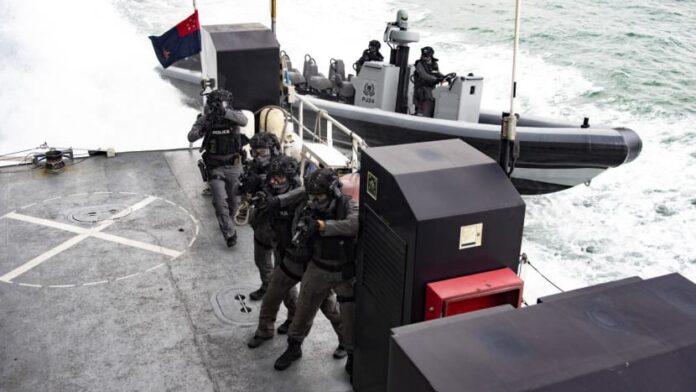Singapore: When the squeak of the motor squeaked through the room, three men sat side by side in a boat-shaped structure. The structure in the swimming pool was rotated 180 degrees, turning these people upside down.
This is not an amusement park scene, but a training course at the headquarters of the Police Coast Guard (PCG) on Blarney Island. These elite officers from the PCG Special Task Squadron (STS) are now underwater and must find a way out of the structure.
STS handles high-risk maritime public safety operations, such as chasing ships at high speed or boarding suspicious ships.
In March 2019, when an unregistered motor boat entered the waters of Singapore and accelerated towards Punggol Bharat, STS officers were activated and a man jumped off and continued to swim towards the shore.
When the boatman refused to stop despite repeated warnings, the PCG intercepted the boat and arrested the boatman. Another man was arrested in a fence along the coastline of Punggol Bharat.
In 2007, two PCG officials died after their ship chased a speedboat that entered Singapore waters illegally and collided with it. The PCG ship capsized and there were four officers on board.
After an intensive search and rescue operation involving multiple parties, two lightly injured police officers were rescued, and the bodies of the other two were salvaged from the water.

This risk is part of the reason why PCG uses mobile structures (called underwater exit training simulators) to help STS officials better deal with ship capsizing.
In the event of a capsizing accident, the crew must properly take off their equipment, including inflatable life jackets, before swimming out of the bottom of the ship.
During the training simulation, the underwater officer’s head almost rested on the simulator’s floor. Each of them breathed from the emergency oxygen tank, stretched out their life jackets from behind, and then swam out from the side.
Officials responding to overturning situations sometimes react in complete darkness while being trapped under the ship, in potentially strong currents and rough waters.
The simulator was launched in August, similar to the PCG’s high-speed PK interception boat, reproduced these situations, enabling officers to train in a real and safe environment.
For example, the training pool is equipped with wave generators to simulate ocean currents and various sea conditions.
The police said at a press conference on Sunday (November 14): “The simulator can replicate the physical and environmental conditions that may be caused by maritime emergencies, such as the capsize of a ship. In this case, officials will be underwater. Lost in a confined space.” ).
A police spokesperson stated that police officers do not have to complete a specific number of hours on the simulator, but this is part of the pre-deployment training course.
“So far, the feedback we have received is that it is really helpful. This undoubtedly gave them confidence in a completely different training environment,” he said.

BOAT HANDLING SIMULATOR
In addition to actual sea training involving interception and boarding tactics, the underwater exit training simulator is not the first time that PCG uses technology for training.
In March last year, it commissioned a tactical ship manipulation and shooting simulator to practice high-risk maneuvers, surveillance and navigation in different scenarios at sea.
The simulator is equipped with an advanced physics engine that uses actual ship performance data to replicate the behavior of high-speed ships in the real world when they are affected by waves or impacts with other ships and floating objects.
The simulator is also equipped with an eye tracker, which can help trainers analyze the officer’s visual focus in stressful situations such as high-speed pursuits, and provide feedback on how to improve.

PCG commander Senior Assistant Commissioner of Police Cheang Keng Keong said at the time that the simulator will minimize the risk of injuries and accidents.
The police said on Sunday: “The high-risk exercises performed by STS personnel during high-speed interception and tactical boarding require STS personnel to hone their skills to perfection, because errors are not allowed during the operation.”
When asked whether the 2007 incident was involved in the development of the underwater exit training simulator, a police spokesperson said that this provided some lessons and was part of the consideration.
“But what is more important is to actually improve the operational capabilities of our officers when handling certain situations at sea, such as capsizing exercises,” he said.
“We built this simulator to help train all our frontline personnel. This is indeed a need for operational requirements.”






